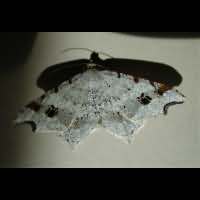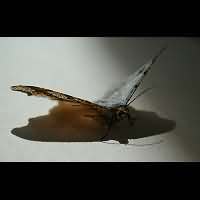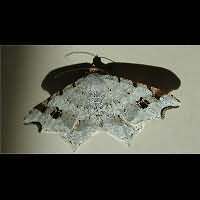Sharp-angled Peacock Moth (Macaria alternata)
There is only one species similar to the Sharp-angled Peacock Moth: the Peacock Moth. Both are quite light, have a brown spot on the edge of the wing and a bigger and darker spot a little further on and the hindwings are angled. The Peacock Moth usually is much whiter than the Sharp-angled Peacock. The Peacock also has a thin greyish line running just above the brown and blackish dots. In the Sharp-angled Peacock these spots are within a broad, greyish band. The shape of the angled hind wings differs also and the Sharp-angled Peacock has the concave part of the forewing, just below the tip of the wing, entirely dark brown, including the fringes. The Peacock just has a (much lighter) brown line there, which does not effect the fringes. Once you have seen them both together, you usually can tell them apart by their shape. However very worn species can sometimes be puzzling. The wingspan of the Peacock Moth is 27 to 32 mm.
The caterpillar is extrmely variable: green, grey or brown. The markings differ both in colour and shape according to the ground colour. It may grow up to 24 mm. The larvae of the first generation may grow extremely quickly. Within 5 weeks the first moths may appear. The caterpillars of the 2nd generation also grow quickly in September. In October they disappear underground where they pupate and overwinter as pupa. The foodplants are Sallow, Blackthorn and Alder and a few other species.
The Sharp-angled Peacock Moth is double brooded. It is on the wing in May, June and August mainly. It flies from dusk onwards. During the day it is more difficult to find than the Peacock and is not easily disturbed. The Sharp-angled Peacock is however more easily attracted to light. A widespread but very local species in Southern England and Southern Wales. Very rare in Northern England, Northern Wales and Ireland, not present in Scotland. Also a rather common but local species on the continent.
This species is scientifically also known as Semiothisa alternata and Semiothisa alternaria.
There is only one species similar to the Sharp-angled Peacock Moth: the Peacock Moth. Both are quite light, have a brown spot on the edge of the wing and a bigger and darker spot a little further on and the hindwings are angled. The Peacock Moth usually is much whiter than the Sharp-angled Peacock. The Peacock also has a thin greyish line running just above the brown and blackish dots. In the Sharp-angled Peacock these spots are within a broad, greyish band. The shape of the angled hind wings differs also and the Sharp-angled Peacock has the concave part of the forewing, just below the tip of the wing, entirely dark brown, including the fringes. The Peacock just has a (much lighter) brown line there, which does not effect the fringes. Once you have seen them both together, you usually can tell them apart by their shape. However very worn species can sometimes be puzzling. The wingspan of the Peacock Moth is 27 to 32 mm.
The caterpillar is extrmely variable: green, grey or brown. The markings differ both in colour and shape according to the ground colour. It may grow up to 24 mm. The larvae of the first generation may grow extremely quickly. Within 5 weeks the first moths may appear. The caterpillars of the 2nd generation also grow quickly in September. In October they disappear underground where they pupate and overwinter as pupa. The foodplants are Sallow, Blackthorn and Alder and a few other species.
The Sharp-angled Peacock Moth is double brooded. It is on the wing in May, June and August mainly. It flies from dusk onwards. During the day it is more difficult to find than the Peacock and is not easily disturbed. The Sharp-angled Peacock is however more easily attracted to light. A widespread but very local species in Southern England and Southern Wales. Very rare in Northern England, Northern Wales and Ireland, not present in Scotland. Also a rather common but local species on the continent.
This species is scientifically also known as Semiothisa alternata and Semiothisa alternaria.






